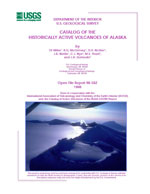Sugarloaf Peak 1987/4
Start: April 13, 1987 [1]
Stop: May 26, 1987 [2]
Event Type: Explosive
Max VEI: 2 [3]
- Steam [2]
Description: Miller and others (1998): "The latest reported activity occurred on April 13, 1987 when a plume extending 90 km ENE from Semisopochnoi Island was observed on satellite imagery; the plume extended only 15 km ENE several hours later. On April 24, 1987, a commercial pilot flying about 50 km SE of the island observed that one of the snow-covered peaks, possibly Sugarloaf, was blackened (Smithsonian Institution, 1987)."
From Reeder (1990): "Steve Shivers of the U.S. Geological Survey Anchorage Office noted an eruption plume at about 52 degrees N, 180 degrees W from a 17:31:03LT (=GMT -9 hours) 13 April 1987 U.S. NOAA 9 (orbit number 12028) and from a 21:35:29LT 13 April 1987 U.S. NOAA 10 (orbit number 02966) satellite images. The narrow plume extended 90 km to ENE on the 17:31:03LT image, and it extended only 15 km to ENE on the 21:35:29LT image. The source of the eruption plume was located in the Semisopochnoi Island region.
"Pilot Harold E. Wilson of Peninsula Airways Inc. observed midafternoon on 24 April a very dark colored volcanic peak on Semisopochnoi Island when all other peaks and the rest of the island appeared completely white with snow. The upper half of the volcano peak was dark. He roughly determined that the dark volcanic peak was Sugarloaf Peak, which is located on the very southern part of Semisopochnoi Island. Harold was at a distance of about 50 km to SE. At the time, he was unaware of the 13 April NOAA satellite eruption plume images.
"On 18 +/- 2 May, workers employed with Chris Berg Inc. observed a small white steam plume from Sugarloaf Peak that did not drift more than 2 km from the volcano. Their observations of the plume were made from several locations on Amchitka Island.
"Jerry Underhill of Fairweather Inc., as reported to pilot Harold Wilson, observed a very pronounced white steam plume from Sugarloaf Peak on the 26 +/- 2 May. Jerry Underhill is a weather observer for Fairweather Inc. at Amchitka Island. The white steam plume with possible minor ash rose just above the top of Sugarloaf Peak and then trailed to NE for at least 1.5 km."
From Reeder (1990): "Steve Shivers of the U.S. Geological Survey Anchorage Office noted an eruption plume at about 52 degrees N, 180 degrees W from a 17:31:03LT (=GMT -9 hours) 13 April 1987 U.S. NOAA 9 (orbit number 12028) and from a 21:35:29LT 13 April 1987 U.S. NOAA 10 (orbit number 02966) satellite images. The narrow plume extended 90 km to ENE on the 17:31:03LT image, and it extended only 15 km to ENE on the 21:35:29LT image. The source of the eruption plume was located in the Semisopochnoi Island region.
"Pilot Harold E. Wilson of Peninsula Airways Inc. observed midafternoon on 24 April a very dark colored volcanic peak on Semisopochnoi Island when all other peaks and the rest of the island appeared completely white with snow. The upper half of the volcano peak was dark. He roughly determined that the dark volcanic peak was Sugarloaf Peak, which is located on the very southern part of Semisopochnoi Island. Harold was at a distance of about 50 km to SE. At the time, he was unaware of the 13 April NOAA satellite eruption plume images.
"On 18 +/- 2 May, workers employed with Chris Berg Inc. observed a small white steam plume from Sugarloaf Peak that did not drift more than 2 km from the volcano. Their observations of the plume were made from several locations on Amchitka Island.
"Jerry Underhill of Fairweather Inc., as reported to pilot Harold Wilson, observed a very pronounced white steam plume from Sugarloaf Peak on the 26 +/- 2 May. Jerry Underhill is a weather observer for Fairweather Inc. at Amchitka Island. The white steam plume with possible minor ash rose just above the top of Sugarloaf Peak and then trailed to NE for at least 1.5 km."
References Cited
[1] Semisopochnoi, 1987
Smithsonian Institution, 1987, Semisopochnoi: Scientific Event Alert Network Bulletin v. 12, n. 04, unpaged.[2] Sugarloaf, 1990
Reeder, J. W., 1990, Sugarloaf: in Annual report of the world volcanic eruptions in 1987, Bulletin of Volcanic Eruptions, v. 27, p. 36.[3] Volcanoes of the world [2nd edition], 1994
Simkin, Tom, and Siebert, Lee, 1994, Volcanoes of the world [2nd edition]: Tucson, Arizona, Geoscience Press, 349 p.Complete Eruption References
Catalog of the historically active volcanoes of Alaska, 1998
Miller, T. P., McGimsey, R. G., Richter, D. H., Riehle, J. R., Nye, C. J., Yount, M. E., and Dumoulin, J. A., 1998, Catalog of the historically active volcanoes of Alaska: U.S. Geological Survey Open-File Report 98-0582, 104 p.

Volcanoes of the world [2nd edition], 1994
Simkin, Tom, and Siebert, Lee, 1994, Volcanoes of the world [2nd edition]: Tucson, Arizona, Geoscience Press, 349 p.
Hard Copy held by AVO at FBKS - CEC shelf
Sugarloaf, 1990
Reeder, J. W., 1990, Sugarloaf: in Annual report of the world volcanic eruptions in 1987, Bulletin of Volcanic Eruptions, v. 27, p. 36.
Hard Copy held by AVO at FBKS - CEC file cabinet
Semisopochnoi, 1987
Smithsonian Institution, 1987, Semisopochnoi: Scientific Event Alert Network Bulletin v. 12, n. 04, unpaged.